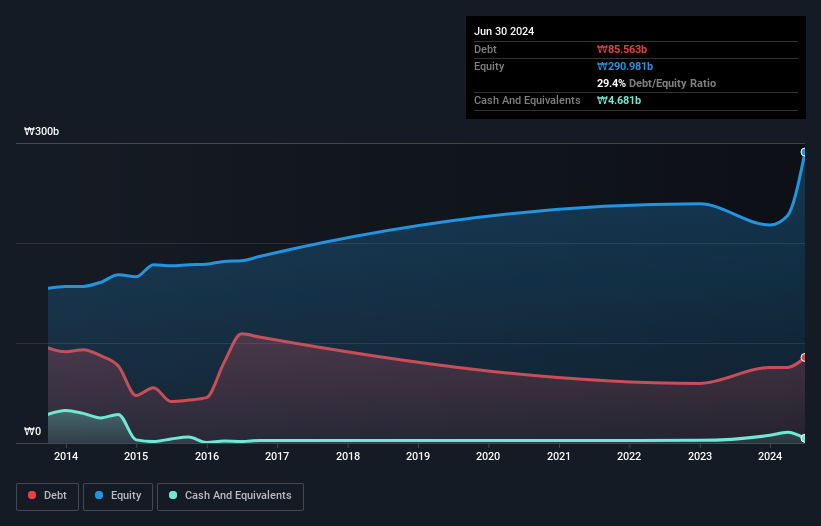
Some say volatility, rather than debt, is the best way to think about risk as an investor, but Warren Buffett famously said that 'Volatility is far from synonymous with risk.' It's only natural to consider a company's balance sheet when you examine how risky it is, since debt is often involved when a business collapses. We can see that SAJO SEAFOOD Co.,Ltd (KRX:014710) does use debt in its business. But the more important question is: how much risk is that debt creating?
What Risk Does Debt Bring?
Debt and other liabilities become risky for a business when it cannot easily fulfill those obligations, either with free cash flow or by raising capital at an attractive price. If things get really bad, the lenders can take control of the business. However, a more common (but still painful) scenario is that it has to raise new equity capital at a low price, thus permanently diluting shareholders. Of course, plenty of companies use debt to fund growth, without any negative consequences. When we think about a company's use of debt, we first look at cash and debt together.
See our latest analysis for SAJO SEAFOODLtd
What Is SAJO SEAFOODLtd's Net Debt?
As you can see below, at the end of June 2024, SAJO SEAFOODLtd had ₩85.6b of debt, up from ₩59.6b a year ago. Click the image for more detail. However, because it has a cash reserve of ₩4.68b, its net debt is less, at about ₩80.9b.

How Healthy Is SAJO SEAFOODLtd's Balance Sheet?
The latest balance sheet data shows that SAJO SEAFOODLtd had liabilities of ₩100.0b due within a year, and liabilities of ₩29.4b falling due after that. Offsetting these obligations, it had cash of ₩4.68b as well as receivables valued at ₩19.1b due within 12 months. So it has liabilities totalling ₩105.6b more than its cash and near-term receivables, combined.
This deficit is considerable relative to its market capitalization of ₩133.8b, so it does suggest shareholders should keep an eye on SAJO SEAFOODLtd's use of debt. This suggests shareholders would be heavily diluted if the company needed to shore up its balance sheet in a hurry. There's no doubt that we learn most about debt from the balance sheet. But you can't view debt in total isolation; since SAJO SEAFOODLtd will need earnings to service that debt. So if you're keen to discover more about its earnings, it might be worth checking out this graph of its long term earnings trend.
Over 12 months, SAJO SEAFOODLtd made a loss at the EBIT level, and saw its revenue drop to ₩181b, which is a fall of 4.0%. We would much prefer see growth.
Caveat Emptor
Importantly, SAJO SEAFOODLtd had an earnings before interest and tax (EBIT) loss over the last year. Indeed, it lost a very considerable ₩16b at the EBIT level. Considering that alongside the liabilities mentioned above does not give us much confidence that company should be using so much debt. Quite frankly we think the balance sheet is far from match-fit, although it could be improved with time. We would feel better if it turned its trailing twelve month loss of ₩6.8b into a profit. So to be blunt we do think it is risky. When analysing debt levels, the balance sheet is the obvious place to start. But ultimately, every company can contain risks that exist outside of the balance sheet. We've identified 2 warning signs with SAJO SEAFOODLtd , and understanding them should be part of your investment process.
Of course, if you're the type of investor who prefers buying stocks without the burden of debt, then don't hesitate to discover our exclusive list of net cash growth stocks, today.
New: Manage All Your Stock Portfolios in One Place
We've created the ultimate portfolio companion for stock investors, and it's free.
• Connect an unlimited number of Portfolios and see your total in one currency
• Be alerted to new Warning Signs or Risks via email or mobile
• Track the Fair Value of your stocks
Have feedback on this article? Concerned about the content? Get in touch with us directly. Alternatively, email editorial-team (at) simplywallst.com.
This article by Simply Wall St is general in nature. We provide commentary based on historical data and analyst forecasts only using an unbiased methodology and our articles are not intended to be financial advice. It does not constitute a recommendation to buy or sell any stock, and does not take account of your objectives, or your financial situation. We aim to bring you long-term focused analysis driven by fundamental data. Note that our analysis may not factor in the latest price-sensitive company announcements or qualitative material. Simply Wall St has no position in any stocks mentioned.
About KOSE:A014710
SAJO SEAFOODLtd
Engages in the food, deep sea fishing, and frozen food storage businesses in South Korea.
Mediocre balance sheet low.
Market Insights
Community Narratives



